|
Thurs., April 26
9:00 a.m. - 1:00 p.m.
TESLA Technology Collaboration meeting
1 West
View schedule here.
1:00 p.m.
ALCPG ILC Physics and Detector Seminar - West Wing, WH-10NW
Speaker: M. Barone, Fermilab
Title: The ILC Document Server Project Suite: ILCAgenda, ILCDoc, ILC-EDMS
2:30 p.m.
Theoretical Physics Seminar - Curia II
Speaker: A. Weber, Max Planck Institute, Munich
Title: Dusting for SUSY's Fingerprints in Precision Data
3:30 p.m.
DIRECTOR'S COFFEE BREAK - 2nd Flr X-Over
4:00 p.m.
Accelerator Physics and Technology Seminar
1 West
Speaker: R. Raja, Fermilab
Title: Accelerator Driven Nuclear Energy - The Thorium Option
6:00 p.m.
UTeV Seminar - 1 West
Speaker: M. Demarteau, Fermilab
Title: A Walmart ILC Detector?
Fri., April 27
3:30 p.m.
DIRECTOR'S COFFEE BREAK - 2nd Flr X-Over
4:00 p.m.
Joint Experimental-Theoretical Physics Seminar - 1 West
Speaker: A. Schwartz, University of Cincinnati
Title: Evidence for D0-D0bar Mixing at Belle
Click here for NALCAL,
a weekly calendar with links to additional information. |
Thursday, April 26
-Santa Fe black bean
-Sloppy Joe
-Chicken Cordon Bleu
-Sauteed liver & onions
-Baked Ham & Swiss on ciabatta Roll
-Assorted pizza slices
-Crispy fried chicken ranch salad
Wilson Hall Cafe Menu |
Thursday, April 26
Dinner
- Coquille St. Jacques
- Veal piccata
- Risotto confetti
- Chocolate fondue w/ dipping fruit
Wednesday, May 2
Lunch
- Calzone w/ sausage
- Roasted red peppers and 3 cheeses
- Romaine w/ cherry tomatoes & red onion
- Mocha cake
Chez Leon Menu
Call x4598 to make your reservation. |
|
|
SciBooNE's aggressive move targets June commissioning
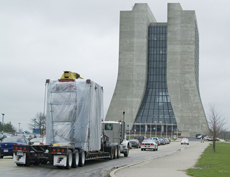 A truck carries the SciBar detector to its new home in the SciBooNE building on Wednesday. The three major components of the experiment were moved into place this week.
A truck carries the SciBar detector to its new home in the SciBooNE building on Wednesday. The three major components of the experiment were moved into place this week.
As the first element of the SciBooNE experiment safely landed in place Monday afternoon, SciBooNE cospokesperson Morgan Wascko and a group of collaborators broke into applause. Two days later, the final piece was lowered into the SciBooNE building, marking the end of a nail-biting week for those involved in the experiment, and the beginning of what project head Rick Tesarek hopes will be a quick and painless setup process. "This is incredibly exciting," he said.
Although much work remains, Tesarek expects that SciBooNE will be commissioning by middle of June.
"That is an aggressive schedule, but everything we've done here is aggressive," said Tesarek. "We will be taking data before shutdown." The Fermilab accelerator complex will be shut down for maintenance in August.
Once up and running, the SciBooNE experiment will measure precise cross sections of neutrino interactions. Through data collected from each of the detector's three elements -- the SciBar detector, the electromagnetic calorimeter, and the Muon Range Detector -- scientists will be able to retrace the steps of each particle, essentially recreating the reaction itself.
The data is important in itself, allowing scientists to understand more about how neutrinos react with other particles, but it will also prime the way for other experiments, including the T2K experiment in Japan.
"The prime reason for doing this experiment is that the neutrino energies here are expected to match the neutrino energies at the T2K experiment," Tesarek said. "We'll also be trying to fill in the gaps where some measurements don't exist."
The experiment's eventual success, Tesarek said, can be attributed to a large number of individuals, including students Joe Walding and Yasuhiro Nakajima and others who helped to build the SciBar detector, and the technicians who moved it. The experiment is scheduled to run for two years.
-- Rhianna Wisniewski
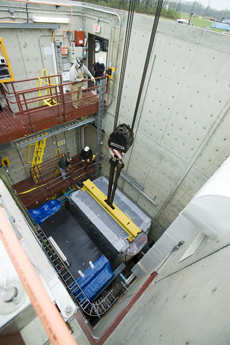 The SciBar detector is lowered 38 feet into the SciBooNE building on Wedneday.
The SciBar detector is lowered 38 feet into the SciBooNE building on Wedneday.
|
Fermilab and partners create network for spouse placement
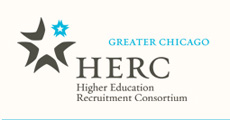 The Greater Chicago Higher Education Recruitment Consortium will help academic, scientific and cultural institutions place spouses and significant others of candidates they are recruiting.
The Greater Chicago Higher Education Recruitment Consortium will help academic, scientific and cultural institutions place spouses and significant others of candidates they are recruiting.
Fermilab has long been a world-class leader in particle physics, but the lab's most recent venture puts it at the leading edge of human relations. The laboratory is one of the initiators and founders of the Greater Chicago Higher Education Recruitment Consortium, a new organization dedicated to addressing what Fermilab deputy director Young-Kee Kim calls "the two-body problem."
The new consortium will create a network of higher administrators from Chicago-area institutions who can work together to find spousal placement. The networking process is something that Kim and other administrators have been informally doing for years. "I'd call all my personal contacts, but it was not the most effective and efficient mechanism since they weren't always the best contacts, resulting in spending a lot of time for a number of people," Kim said.
The fledgling consortium encompasses the five founding members: Fermilab and Argonne Lab, the University of Chicago, the University of Illinois at Chicago, and Northwestern University, which fund and operate the organization. Other consortiums with similar structures exist in regions including New England and California.
An April 18 launch meeting at the University of Illinois at Chicago brought together 60 representatives from higher academic and cultural institutions within 100 miles of Chicago. Institutions have until the May 30 to express their interest in becoming a member.
The April 18 meeting was also good exposure for Fermilab. "It was one way of advertising ourselves to our community - they didn't know much about us," Kim said.
The group has already hired an executive to run the consortium, and is working to set up a web site for an official launch in fall 2007. The next consortium meeting will be at Fermilab in June.
-- Rhianna Wisniewski
|
New Scientist podcast
April 20, 2007:
MiniBooNE interview podcast
An interview of Fermilab's Scott Dodelson, head of the Theoretical Astrophysics department, with New Scientist regarding the MiniBooNE neutrino results. (mp3 file)
Access here |
|
|
Charged on Top
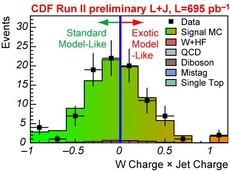
To a "b," or not to a "b:" That is the question for the top quark. Shown is the product of the charge of the W and the associated b quark jet for candidate top quark decays. An excess of data in the exotic-like right-hand side could indicate that the top is not what we think it is. More details below(*).
Determining whether a jet of particles came from a b quark or an oppositely charged anti-b quark is at the heart of an existential question related to quarks: what is the true nature of the top quark? Since the top's discovery at the Tevatron more than 10 years ago, physicists have been asking themselves: Is this elusive particle really the top quark predicted by the Standard Model? Measuring its electric charge would help answer that question. According to the Standard Model, the top quark should have a charge of +2/3 and should decay to a W+ (charge +1) and a b quark (charge -1/3), while the anti-top should decay to a W- (charge -1) and an anti-b quark (charge +1/3).
The charge of the W can be obtained from the charge of the electron or muon it decays into, but what about distinguishing between a b quark and an anti-b quark? A team of CDF physicists answer this question by summing the charges of all the tracks inside a b jet. If the sum comes out positive, they assign the jet to an anti-b quark, and if it is negative, to a b quark. Using this algorithm, they estimate that they make the correct assignment about 60% of the time. This is a tough business!
The CDF physicists find that with about 1 inverse femtobarn of data, the Standard Model hypothesis for the top quark is strongly supported. This seems to indicate that this particle thought to be the top quark might indeed be the top quark...electrically speaking
(*)Continued from above: A perfectly reconstructed top or antitop quark would always have a negative value. Due to misreconstruction, about 60% of the time a correct assignment is expected to be made. In approximately 1fb-1 of data, CDF observed 62 negative and 48 positive events.
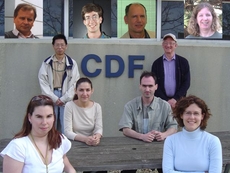
From left, top row: Stanislav Tokar (Comenius University, Bratislava), Kevin McFarland (University of Rochester), Jaroslav Antos (Slovak Academy of Science), and Kirsten Tollefson (Michigan State). Second and third rows, from left: Yen-Chu Chen (Academia Sinica), and Andy Beretvas (Fermilab); Zeynep Gunay Unalan (Michigan State University), and Peter Bednar (Comenius University, Bratislava). Bottom row, from left: Veronique Boisvert (University of Rochester), and Veronica Sorin (Michigan State University).
Learn more
|
Medical Research on the Erasmus Computing Grid
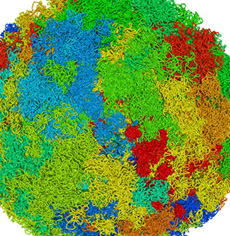
A simulated view of the three-dimensional architecture of genetic material as it appears in a human cell nucleus. Colors signify different chromosomes.
Image courtesy of Tobias A. Knoch, Erasmus Medical Center
Large portions of our DNA, it seems, serve no apparent purpose. Researchers in the field of genomics, however, are interested in all sections and levels of organization of an organism's DNA-from the DNA sequence to the overall morphology of a cell nucleus.
Read More
|
|
Pine Street entrance closing:
Use Wilson Street entrance
Due to inclement weather, not all grinding work could be completed yesterday on outbound Pine Street. Weather may prevent additional paving done today. Motorists on outbound Pine street should be cautious of rough uneven surfaces, bumps, water on road and the lack of pavement markings. Due to repaving operations, both the inbound and outbound lanes of Fermilab's Pine Street entrance will continue to be closed through Friday, April 27. Each day the Pine Street entrance will be closed at 6 a.m. and will reopen by 6 p.m. The Wilson Street entrance will be open between 6 a.m. and 6 p.m. The schedule is dependent on the weather. Fermilab Today will provide updates.
Children's swim lessons
The Aurora YMCA will soon offer children's swim lessons at the Village Pool. Lessons are open to children of employees, users, and approved contractors ages 4 yrs. to 12 yrs. Cost for pre-school lessons is $40.00 and $45.00 for all other classes. Lessons are taught in two-week sessions, Monday through Thursday with Friday as a makeup day. The session dates are: Session 1-Weeks of June 19 & June 26, Session 2-Weeks of June 3 & July 10, Session 3-Weeks of July 17 & July 24 and Session 4-Weeks of July 31 & August 7. More information can be found online or in the Recreation Office.
|
|